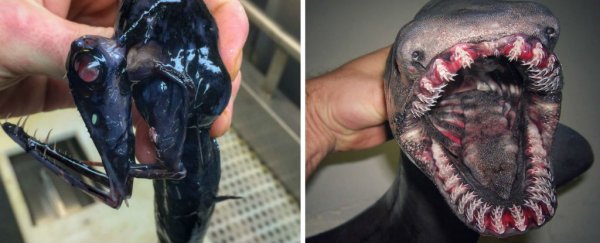We like to say we know less about the ocean here on Earth than we do about the surface of Mars, because while we have a vague idea of its overall structure, we've only properly seen less than 0.05 percent of our oceans.
Imagine we discover an alien planet that's teeming with life, and we've only explored an area the size of the Australian island Tasmania - that's what we're dealing with when it comes to the ocean.
But thanks to this awesome deep-sea diver, we do have a better understanding of what's really down there.
Roman Fedortsov is a deep-sea fisherman based in the port city of Murmansk in Russia, which looks out over the Barents Sea – a relatively shallow sea that opens into the Arctic Ocean.
Fishing throughout the coastal Arctic ocean region, all the way to the coast of Morocco, Fedortsov shares images on social media of the deep-sea creatures that wander into his nets.
And let's just say, you might think you know what an anglerfish looks like, but it's a whole other story to see one close-up, sitting in the palm of someone's hand:
https://twitter.com/rfedortsov/status/808997626666426368
Hello from Hell... pic.twitter.com/HsWXkbmOyH
— Роман Федорцов (@rfedortsov) December 1, 2017
Imagine being hunted by this:
Народ до сих пор спорит... кто это? #рыбалка #промысел #изглубины #рыба #fish #fishing #ты_кто? pic.twitter.com/76VLcK20rB
— Роман Федорцов (@rfedortsov) November 21, 2016
Or this:
My new photo of #frilledshark pic.twitter.com/PaGQVB8gpj
— Роман Федорцов (@rfedortsov) December 2, 2017
If you're wondering why they're all black, aside from red, it's the best colour to be in the deep sea if you don't want to get spotted.
These creatures live in the 'twilight zone' of the ocean – otherwise known as the Mesopelagic – which extends from a depth of 200 to 1,000 meters (roughly 660 to 3,300 feet) below the surface.
Below the Mesopelagic is the bathyal zone, which spans from 1,000 to 4,000 meters deep (3,300 to 13,000 feet), at which point there is zero sunlight.
That means these guys are dealing with only the tiniest hints of light penetration, and because black absorbs every wavelength of light without reflecting any back, they're effectively invisible in their natural habitat.
This also applies to red-hued deep-sea creatures too, as the US National Ocean and Atmospheric Administraation (NOAA) explains:
"The black animals absorb all colours of light available, and the red animals appear black as well; there is no red light to reflect and their bodies absorb all other available wavelengths of light. Thus red and black animals predominate."
Case in point:
Очередная #рыба в ленту) pic.twitter.com/CUwmzBJkDO
— Роман Федорцов (@rfedortsov) July 5, 2016
Before we have a look at some more of these incredible creatures, let's just put it out there that it sucks that these animals died because they were caught up in a fisherman's net, and the best place for them is obviously back safe in their habitat.
But these images give us the opportunity to appreciate and learn more about life on Earth, and the more excited we are about the breadth of life that's lurking in the depths of the ocean, the more likely researchers will be to get the funding they need to actually go down there and study them.
So here are some more of our favourite pics from Fedortsov, and you can see more in his X/Twitter feed:
Как вам такая красавица? Та #химера, которая сегодня попалась в #трал. #фото_с_борта_судна #промысел #Баренцево_море #рыба #улов #зубы pic.twitter.com/gl4WWlCboc
— Роман Федорцов (@rfedortsov) December 11, 2016
Aww.
Linophryne Brevibarbata,commonly called the “Bearded SeaDevils”.This is a female😜
— Роман Федорцов (@rfedortsov) November 24, 2017
Удильщик.Называют «Бородатый Морской Дьявол».Это девочка 😜 pic.twitter.com/sIB6pkEQVL
No need to invent “Monsters”
— Роман Федорцов (@rfedortsov) November 22, 2017
Nature has already done it pic.twitter.com/rWCOkfWAdB
Disapproving look pic.twitter.com/Ge9Q7HFKcg
— Роман Федорцов (@rfedortsov) November 16, 2017
Deepwater redfish (Sebastes mentella) with expressive eyes. Морской окунь с выразительными глазами pic.twitter.com/b1ArjBKg5I
— Роман Федорцов (@rfedortsov) November 8, 2017
I’ll be back in Your Nightmares))) pic.twitter.com/GtrYNvm4pt
— Роман Федорцов (@rfedortsov) October 22, 2017
Yep, definite nightmare material.
An earlier version of this story was published in December 2016.
